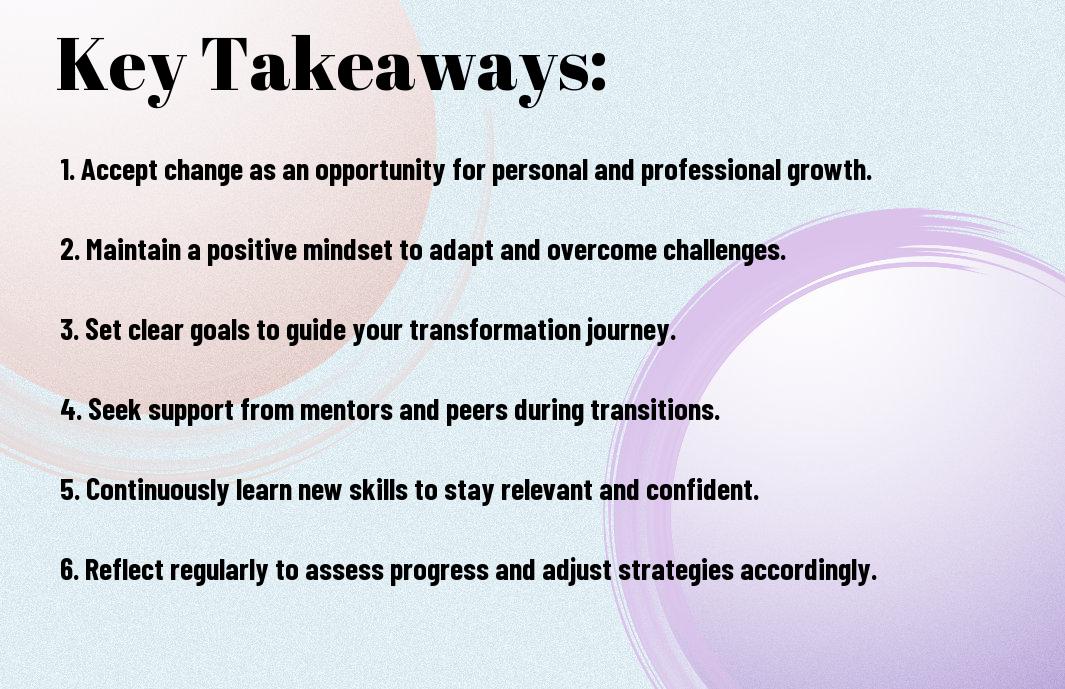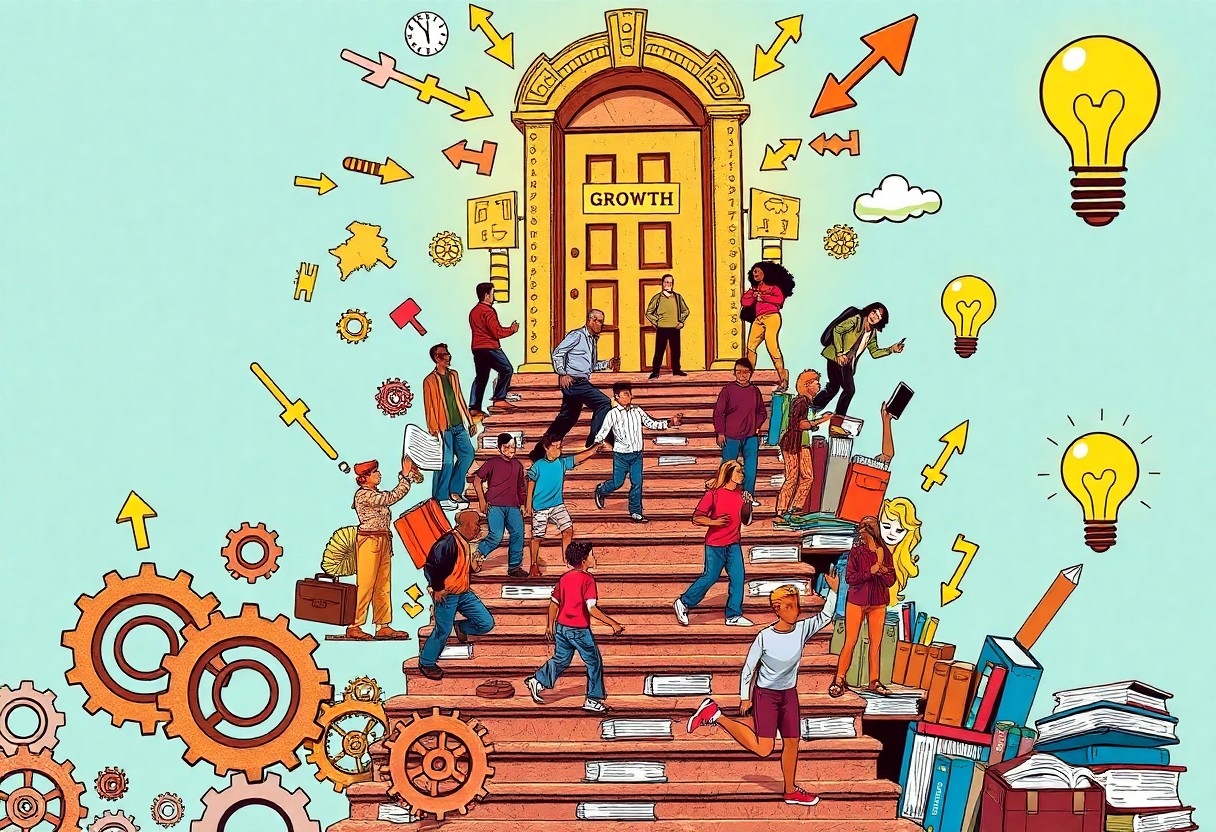Most people find change challenging, yet it is a powerful catalyst for personal and professional growth. By learning how to embrace change effectively, you open doors to new opportunities and insights. This guide will walk you through practical steps to shift your mindset, build resilience, and take actionable measures to harness change as a positive force in your life. Understanding and applying these strategies will empower you to navigate transitions confidently and accelerate your development.
Key Takeaways:
- Recognize and accept change as an opportunity for personal and professional growth rather than a setback.
- Develop a proactive mindset by setting clear goals and seeking new experiences that challenge your comfort zone.
- Build resilience through continuous learning, adapting strategies, and maintaining a positive outlook during transitions.

Reframing Change: A New Perspective
Viewing change through a fresh lens shifts your experience from resistance to opportunity. Rather than seeing disruption as a threat, you can consider it a catalyst for adaptation and learning. This mindset transforms your response, encouraging proactive engagement with new challenges. By redefining change as a process of growth instead of loss, you empower yourself to navigate transitions with confidence and creativity, ultimately unlocking your potential in unpredictable environments.
The Psychology of Change
Your brain tends to favor stability, often triggering stress responses during change due to uncertainty and perceived threats. The limbic system activates fight-or-flight signals, which can impair decision-making. Awareness of these psychological reactions helps you consciously adjust your mindset. By practicing mindfulness or cognitive reframing, you retrain neural pathways, making your response to change less about fear and more about curiosity and resilience.
Benefits of Embracing Uncertainty
Welcoming uncertainty opens the door to innovation and personal growth. It challenges you to develop new skills, expand your comfort zone, and become adaptable. Studies show that individuals who tolerate ambiguity are more likely to seize unexpected opportunities and cultivate creativity, which is important for thriving in rapidly evolving situations. Embracing uncertainty means stepping into the unknown with confidence, knowing it holds potential rather than peril.
Delving deeper, embracing uncertainty enhances cognitive flexibility—the ability to switch perspectives and consider diverse solutions. This adaptability accelerates problem-solving and decision-making effectiveness. For example, entrepreneurs who view market fluctuations as chances to pivot often outperform competitors stuck in rigid strategies. Furthermore, tolerating uncertainty reduces anxiety and builds emotional resilience, enabling you to face future changes with greater ease and composure.

Building Resilience: Your Personal Growth Shield
Resilience serves as the foundation that enables you to navigate change with strength rather than surrendering to overwhelm. Cultivating this inner shield allows you to bounce back from setbacks faster and transform challenges into stepping stones for growth. By sharpening your mental flexibility and emotional stamina, you become better equipped to sustain momentum toward your evolving goals despite uncertainty.
Developing a Growth Mindset
Shifting your perspective to embrace learning over perfection transforms obstacles into opportunities. Researchers at Stanford University demonstrated that individuals with a growth mindset exhibit greater persistence and adaptivity. By focusing on effort, strategies, and incremental progress, you train yourself to respond constructively to failure, using it as feedback to enhance your skills and expand your capabilities with each experience.
Techniques for Managing Stress
In stressful moments, specific practices like deep breathing, mindfulness meditation, or progressive muscle relaxation can markedly reduce physical tension and mental clutter. Regularly integrating these techniques helps you maintain clarity and emotional balance, preventing stress from undermining your decision-making and energy levels amid change.
Diving deeper, techniques such as diaphragmatic breathing slow your heart rate and stimulate the parasympathetic nervous system, promoting calmness within minutes. Mindfulness meditation, by training your attention to stay grounded in the present, reduces rumination on past difficulties or future anxieties. Progressive muscle relaxation systematically releases bodily tension by alternating between tightening and loosening muscle groups. Studies reveal consistent practice of these methods lowers cortisol levels and improves overall resilience, enabling you to face challenges without becoming overwhelmed emotionally or physically.
Strategic Planning: Mapping the Path Forward
Strategic planning transforms abstract ideas about change into concrete actions by creating a clear roadmap. You’ll identify key milestones that align with your broader vision, ensuring each step moves you closer to your desired growth. Breaking down goals into manageable phases allows you to monitor progress and recalibrate approaches when necessary. Incorporating feedback loops, such as regular review meetings or data tracking tools, helps maintain momentum and responsiveness throughout the journey.
Setting SMART Goals for Change
Define goals that are Specific, Measurable, Achievable, Relevant, and Time-bound (SMART) to maintain focus and accountability. For example, rather than stating “improve customer satisfaction,” aim for “increase customer satisfaction scores by 10% within six months” by implementing targeted service training. SMART goals provide a clear target, so you can track progress objectively and adjust strategies confidently based on real-world results.
The Role of Adaptability in Planning
Adaptability serves as the backbone of successful strategic plans, allowing you to pivot when circumstances shift or new opportunities arise. By staying flexible, you empower yourself to respond effectively to unexpected challenges without losing sight of your ultimate objectives.
Diving deeper, adaptability in planning means integrating contingency options at each stage of your roadmap. Take Netflix’s transformation from DVD rentals to streaming; their ability to revise strategic plans quickly when digital trends emerged led to market dominance. Similarly, incorporating regular strategy audits enables you to reassess assumptions and adjust goals dynamically. The balance between a clear plan and the agility to modify it ensures growth is sustainable even amid volatile conditions. Remaining open to input and data-driven insights prevents stagnation and keeps your progress aligned with evolving environments.

Harnessing the Power of Community: Collective Growth
Building a network of like-minded individuals and groups amplifies your ability to navigate change and accelerate personal or professional growth. By engaging with a community, you tap into shared resources, diverse experiences, and fresh perspectives that challenge and expand your thinking. This collaboration drives innovation, fosters accountability, and enriches your problem-solving toolkit, making transformation less daunting and more sustainable.
Networking for Support and Resources
Networking extends beyond exchanging business cards; it’s about creating meaningful relationships that provide support and access to resources when you need them most. Connecting with mentors, peers, or industry groups often opens doors to opportunities, insights, and advice that might remain hidden if you work in isolation. Actively nurturing these relationships gives you a dynamic support system to lean on during times of change.
Collaborating for Greater Impact
Collaborating with others combines diverse strengths and expertise, multiplying the impact you can achieve. When you join forces on projects or initiatives, you benefit from complementary skills, shared responsibilities, and innovative ideas emerging from collective brainstorming. This synergy often results in outcomes that exceed individual efforts, accelerating progress and fostering deeper learning within your community.
Expanding on collaboration, consider how cross-disciplinary teams in organizations enhance product development by merging technical skills with creative marketing insights, reducing time-to-market by up to 30%. Similarly, community groups that co-create solutions for local challenges often secure larger grants and public recognition, demonstrating how combined resources and unified vision yield tangible successes faster than solo endeavors.
Measuring Progress: Evaluating Your Journey
Tracking how far you’ve come ensures you stay aligned with your growth objectives. Reflect on completed milestones, increased skills, or shifts in mindset to evaluate your transformation. Quantitative data paired with qualitative insights helps reveal patterns in your development. By consistently measuring progress, you maintain momentum and gain clarity on what strategies are driving meaningful change.
Key Metrics to Track Personal Growth
Monitoring indicators like time spent learning new skills, frequency of stepping outside your comfort zone, or the quality of your relationships offers measurable benchmarks for growth. For example, if you’ve committed to improving communication, count successful networking interactions or feedback scores. Tracking emotional resilience through journaling mood patterns also provides tangible evidence of your evolving mindset.
Adjusting Strategies Based on Feedback
Feedback acts as a mirror reflecting how your actions impact your progress. Analyzing input from mentors, peers, or self-assessments highlights strengths to leverage and gaps to address. By interpreting this information objectively, you can recalibrate your approach—introducing new techniques or reinforcing effective habits—to better align with your goals.
Diving deeper, adapting strategies based on feedback involves actively seeking both positive and constructive critiques. If a mentor notes that your time management is hampering project completion, experimenting with tools like the Pomodoro Technique or priority matrices can enhance efficiency. Similarly, if peers observe hesitation in decision-making, deliberate practice in low-stakes situations builds confidence. This iterative process—testing adjustments, observing results, and refining further—ensures your growth strategy remains dynamic and responsive to real-world insights.
Conclusion
To wrap up, embracing change requires you to cultivate an open mindset, actively seek new experiences, and remain adaptable. By acknowledging challenges as opportunities for growth, you empower yourself to navigate uncertainty confidently. Taking deliberate steps—such as setting clear goals, seeking feedback, and reflecting on progress—helps you unlock your full potential. Ultimately, your willingness to embrace change acts as a catalyst for personal and professional development, enabling continuous learning and lasting success.
FAQ
Q: What are the initial steps to effectively embrace change in a professional environment?
A: The first steps include acknowledging the need for change and maintaining an open mindset toward new possibilities. It is important to assess the current situation, understand the reasons behind the change, and clarify your goals. Building awareness helps reduce resistance and prepares you mentally to adapt efficiently.
Q: How can one manage feelings of uncertainty and fear during periods of change?
A: Managing uncertainty and fear involves practicing self-reflection and seeking support from colleagues, mentors, or professional networks. Focusing on small, manageable tasks helps create momentum and build confidence. Additionally, cultivating resilience through mindfulness and stress-reduction techniques can improve your emotional response to change.
Q: What strategies can be used to leverage change as an opportunity for personal and professional growth?
A: Strategies to unlock growth include setting clear, achievable objectives aligned with the change and actively seeking feedback to improve. Embracing continuous learning by acquiring new skills and knowledge allows you to stay adaptable. Networking and collaborating with others during transition periods can also enhance creativity and open doors to new opportunities.


Leave a Reply